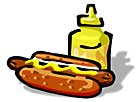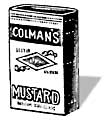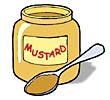|
|
Mustard: Cutting It and Otherwise
by Marjorie Dorfman
|
 Prepared mustard, as we know it today began in Dijon, France in the 13th century and is credited to the efforts of one man, Jean Naigeon. However, the monasteries of the region probably developed the art of mustard making much earlier. Naigeon’s major accomplishment was that he substituted verijuice, the sour juice made from unripe grapes, for the usual vinegar used to grind the mustard seeds into a thick paste. The result was a less acidic and smoother tasting mustard. In fact, the term Dijon Mustard refers to this recipe and not to the city itself. The state enacted strict laws to govern the methods of making mustard and the ingredients allowed in its manufacture. Even today, French law regulates that only the brown seed can be used in the production of Dijon mustard. Over the years, the French have brought mustard making to new culinary heights and today Dijon mustard is the standard against which all mustards are measured. (Do they really cut it though? I’m afraid that only their hairdresser knows for sure!) Prepared mustard, as we know it today began in Dijon, France in the 13th century and is credited to the efforts of one man, Jean Naigeon. However, the monasteries of the region probably developed the art of mustard making much earlier. Naigeon’s major accomplishment was that he substituted verijuice, the sour juice made from unripe grapes, for the usual vinegar used to grind the mustard seeds into a thick paste. The result was a less acidic and smoother tasting mustard. In fact, the term Dijon Mustard refers to this recipe and not to the city itself. The state enacted strict laws to govern the methods of making mustard and the ingredients allowed in its manufacture. Even today, French law regulates that only the brown seed can be used in the production of Dijon mustard. Over the years, the French have brought mustard making to new culinary heights and today Dijon mustard is the standard against which all mustards are measured. (Do they really cut it though? I’m afraid that only their hairdresser knows for sure!)
 The English have developed their own style of mustard down through the ages. It was originally made in homes or monasteries, with little commercial gain involved. In the mid 1600s, the town of Tewksbury in Gloucestershire became famous for its thick horseradish mustard that was the rage of English cookery. Shakespeare (a mustard lover himself) wrote; "His wit is as thick as Tewksbury mustard!" (Henry IV, part II). The greatest name in English mustard however, came in the early 19th century when Jeremiah Colman began milling seeds at Norwich, England. The Colmans were the first to mill the heart of the seed into a fine powder known as mustard flour. Through the use of brilliant marketing techniques, theirs became the quintessential English mustard. Its most famous advertising campaign was The Mustard Club, a whimsical, fictitious coterie of odd characters (Master Mustard, Lady Di Gester and its president Baron de Beef, to name a few.) The English have developed their own style of mustard down through the ages. It was originally made in homes or monasteries, with little commercial gain involved. In the mid 1600s, the town of Tewksbury in Gloucestershire became famous for its thick horseradish mustard that was the rage of English cookery. Shakespeare (a mustard lover himself) wrote; "His wit is as thick as Tewksbury mustard!" (Henry IV, part II). The greatest name in English mustard however, came in the early 19th century when Jeremiah Colman began milling seeds at Norwich, England. The Colmans were the first to mill the heart of the seed into a fine powder known as mustard flour. Through the use of brilliant marketing techniques, theirs became the quintessential English mustard. Its most famous advertising campaign was The Mustard Club, a whimsical, fictitious coterie of odd characters (Master Mustard, Lady Di Gester and its president Baron de Beef, to name a few.)
Mustard use in America evolved differently. First of all, very little was used until the beginning of the twentieth century. Francis French, a New York spice merchant, developed a mild yellow mustard sauce that quickly caught the attention of the American public. French’s Cream Salad Mustard became the national rage. At the same time, J.W. Raye was producing a similar sauce for the sardine packing industry. Some claim that Mr. French and Mr. Raye entered into a "gentleman’s agreement" under which French promised to keep away from the then lucrative sardine market and Raye did the same with respect to the then speculative domestic household market. French’s destiny is of course, very clear, but the Raye Company is no slouch by any means and has survived the competition with its own line of specialty mustards.
 So whether you prefer mild or spicy, cut your own mustard or have someone come in once a week to do it, the mustard in your life must be treated with respect and reverence. Place it in a prominent place in your cupboard or refrigerator. The next time you bite into a meat sandwich slathered with the wonderful concoction, close your eyes and think of the ancient pharaohs. They too probably experienced the very same sensations. If you don’t have that kind of imagination, then think of Chico Marx. If he can’t make you enjoy the mustard, then at least he can make you laugh! So whether you prefer mild or spicy, cut your own mustard or have someone come in once a week to do it, the mustard in your life must be treated with respect and reverence. Place it in a prominent place in your cupboard or refrigerator. The next time you bite into a meat sandwich slathered with the wonderful concoction, close your eyes and think of the ancient pharaohs. They too probably experienced the very same sensations. If you don’t have that kind of imagination, then think of Chico Marx. If he can’t make you enjoy the mustard, then at least he can make you laugh!
Did you know . . .
|
|
|
|
 |
Zenobia Nuts
We used to order from Zenobia Company back in the sixties. Delighted to find them online.

Free Express Shipping on Delicious Roasted and Salted Cashews
Click Here!
|
 "Our lives are not in the lap of the gods, but in the lap of our cooks." "Our lives are not in the lap of the gods, but in the lap of our cooks."
Lin Yutang
The Importance of Living, 1937
"Talk of Joy: there may be things better than beef stew and baked potatoes and home-made bread
. . . there may be."
David Grayson
Adventures in Contentment, 1907
|

Click for a printer friendly version of this article.
|
|